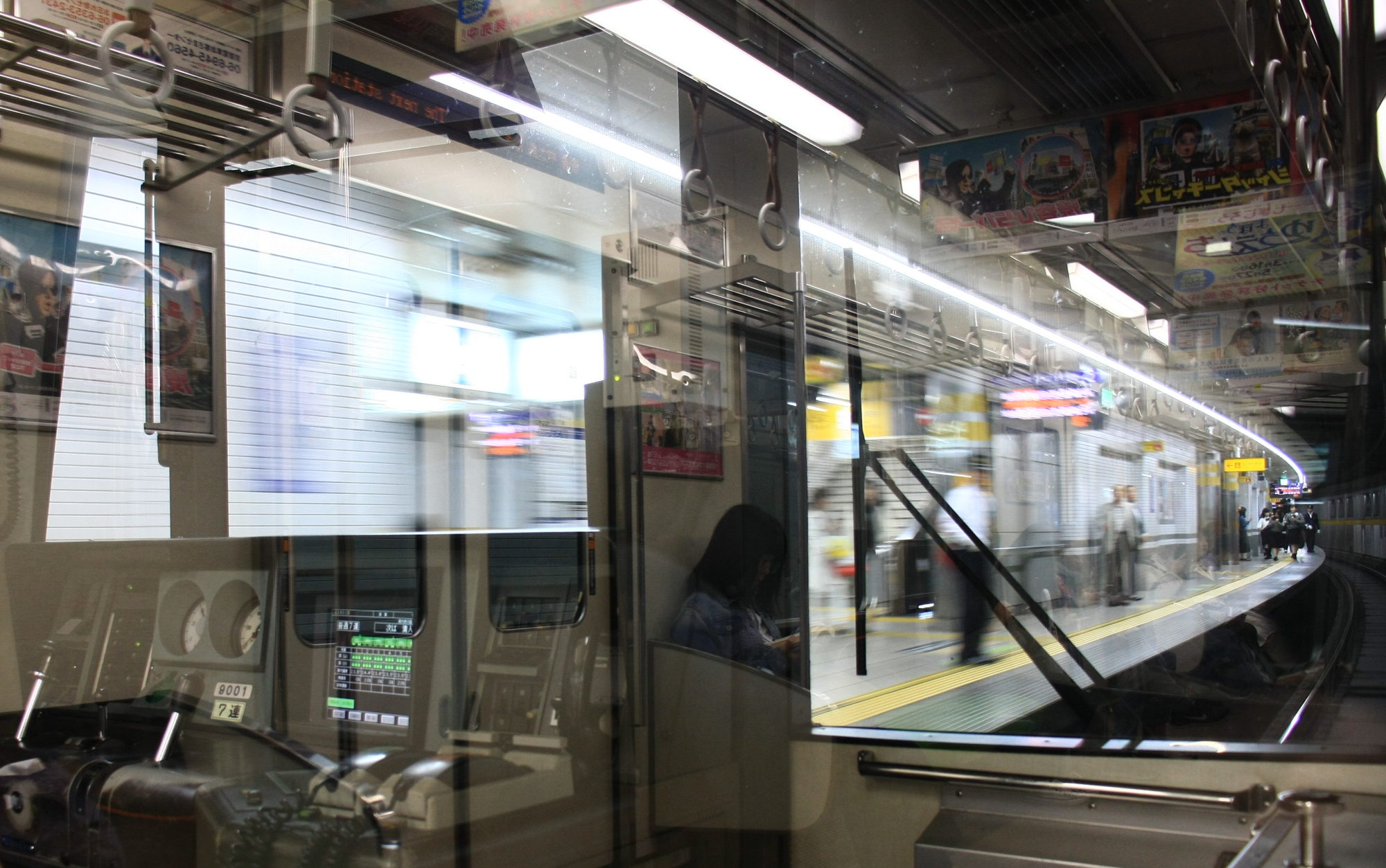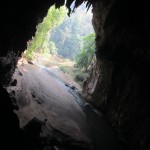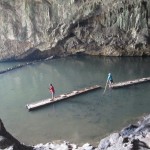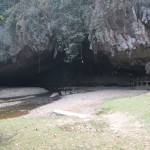I made a small video from the footage taken during the Pai to Chiang Mai leg of my Thailand motorcycle trip. Go here, for the post detailing the day.
Thailand motorcycle trip day 4 : Pai to Chiang Mai
Departure: 11:30 Arrival: 18:30
Date: 12/03/2014
Weather: sunny
Not so fresh on that morning due to overconsumption of malted beverages, Jesse, me and Georgia gathered at the hostel’s reception to figure out how we could fit her and her belongings onto our bikes. Luckily, I had brought some straps (part of the backpack repair kit), so it was decided that since my bike was a little roomier, I would carry her. Her stuff would be attached to Jesse’s luggage rack and the smaller objects would get distributed between our front baskets. With everything secured and stable, off we went on the very windy road to Chiang Mai, so windy in fact that on here way here, Georgia got carsick.

Going uphill was a lot more tedious than before since I was carrying another person and on downhills, I had to be extra careful. Watch for hairpin turns, take into consideration all the grease, oil and gravel on the surface and be extra wary of all the potholes for Georgia had put her safety in my hands. Kudos to her though, she had rented a scooter while in Pai and two days before had bailed while down a dirt path too steep for her to handle. Jesse and I had figured that she might have been scared off motorcycles for some times but no, her only words were: I’m not gonna tell my mom. Originally, she was also okay with making the trip without an helmet; not that she did not care about safety but in Thailand, most people don’t wear them. A couple of minutes out of Pai, in a stroke of luck, I spotted a lone helmet sitting on a post by the side of the road and on inspection, did not appear to belong to anyone and was in good enough condition for her to wear it. The helmets that the hand out with motorcycle rentals are absolute crap and would provide little protection in a crash, but the idea is that if you end up in an accident at least you were wearing one. Also not a bad idea because officially you can get fined for not having one, but none of the police barrages we passed on that trip seemed to care that Thai people were not protected. To extort a bribe, they might make an exception for tourists though.


At one point, we saw a sign for the Pong Duet hot springs and geyser and decided to stop, because its not about the destination but about the journey. At the gate, we got charged more than we thought we’d spent that visit but since we had taken the time to drive the small road there, figured we should give it a chance. Thankfully, it was not a ripoff. The whole park was really nice, the geyser itself a small but proper one (Georgia had never seen one) and the hot-springs well maintained and located in a beautiful setting. Well worth the detour, the complex even had some very nice stone chalets centered around a mineral baths complex in which one day I would very much see myself staying in for a retreat. Satisfied with the experience, we paused at a small kitchen for a meal and pressed on to Chiang Mai.
 The remainder of the road was uneventful, nice for a while, then very ugly when we hit the highway. Finding our way back to the hostel in rush hour traffic provided a small challenge but that was it. Safely home and relieved that everything had gone according to plan, we all rewarded ourselves with a pizza at some Italian restaurant in Chiang Mai, with Jesse and I recounting how this little escape would be the highlight of our time in Thailand and Georgia just sharing that moment of content and happiness with us.
The remainder of the road was uneventful, nice for a while, then very ugly when we hit the highway. Finding our way back to the hostel in rush hour traffic provided a small challenge but that was it. Safely home and relieved that everything had gone according to plan, we all rewarded ourselves with a pizza at some Italian restaurant in Chiang Mai, with Jesse and I recounting how this little escape would be the highlight of our time in Thailand and Georgia just sharing that moment of content and happiness with us.

Thailand motorcycle trip day 3 : Mae Hong Son to Pai
Departure: 10:00 Arrival: 17:00
Date: 11/03/2014
Weather: sunny
Early to bed, early to rise? Not in this case, both Jesse and I clocked in a good 10 hours of sleep before we were up on our feet for another day of riding around. A hearty pad Thai for breakfast and we were back on two tires for the journey to Pai, a tourist stronghold in the region.

The German couple the morning before had suggested us that we should visit the Tham Lot cave. We made a stop at village for gas and a strolled around the market where I got some very tasty but yet to be named fruits and resumed going towards the caves. At the top of a mountain, we finally realized that we had overshot them by several kilometers. Signage in Thailand may be good, we do not know, but those in English can sometimes be a rarity. So we rode back down and found the intersection at which we had to turn.
In order to visit the cave, we had to hire both a bamboo raft, a Thai guide and were also pressured to buy fish food for 10 baht. Fish food? I don’t feed the wildlife. So we went into the cave, checked out some stalactites, checked out some stalagmites, and floated around the river going though which was teeming with catfish. My suspicions got confirmed at the end of the cave, when we noticed that it had been dammed up to keep the fish in so the locals could farm them and have the visitors pay for the food. Otherwise, the cave was worth the detour, but I had seen better ones.
Along the journey, we had attempted to check out other sights as the map indicated lots of waterfalls and nice vistas, but the dry season had gotten there before us. The waterfalls were nothing but trickles and the visibility rendered poor by the bush fires burning everywhere. Deciding not to bother with other sights along the road, in no time we arrived in Pai and got to the Circus Hostel, where Georgia, a friend I had met earlier in Malaysia and Chiang Mai was staying. There, we were informed that a nearby waterfall still had sufficient flow to allow for a swim so after putting on our bathing suits, back on the bikes we jumped. That night, we ate at the night market, Jesse tried eating a giant water bug but had to spew it out and we all finished ourselves at a local bar watching fire shows.
Georgia was supposed to leave Pai the next day to return to Chiang Mai and since we were going the same way we offered her and her big back pack a ride, which to our surprise, she accepted.
Thailand motorcycle trip day 2 : Mae Na Chon to Mae Hong Son
Departure: 11:00 Arrival: 17:00
Date: 09/03/2014
Weather: sunny

At this very Thai cabin resort in the middle of nowhere Northern Thailand, a German couple with two kids was overnighting in a neighboring chalet. We had struck a small conversation the night before with the man but the next morning, we learned that they were doing the same circuit as us but in the reverse direction. Upon questioning them about their mean of transportation (we had seen one scooter in front of their room), the husband quickly replied that his wife did not drive and that that 125cc scooter was the vehicle carrying the whole family around on the journey. What? Four of them on a scooter. I mean, it’s a pretty common sight in Asia, but I would never have thought that a German couple with means probably well above those of the average Thai household was travelling in that region’s famous driving style: the man driving, a backpack and a kid between his legs, another kid behind and lastly the wife at the very back (with room for a baby in the front basket for increased shock absorption in case of collision). “Going uphill is slow and painful, the scooter sounds like its about to die” he added; no wonders.

Much impressed by that family’s courage, we hoped on our machines after a quick breakfast and proceeded for the second leg of our journey and thankfully one that turned out to be rather uneventful. Still riddled with potholes and unpaved stretches, the road was however much nicer than the previous day and with a bit of carefulness afforded us some very pleasurable mountain driving. The view was a bit of let-down, the dry season was in full-force so leaves were falling and whatever used to be verdant green was now shades of beige. To add insult to injury, the Thais, for a reason that is sill a mystery to us, light fires everywhere, filling the air with a fog that restricts visibility down to a few kilometers. Some of them burn trash or plant waste, others make way for crops but we saw fires, especially while driving the night before, in places no sane person would ever think about cultivating but then again, the weather could have been so dry that the fires were simply spreading out of control.

The only good vista we could get was at a small road-side cafe, whose waitresses, visibly stoked that some foreigners had elected their little business for a break, gave us a bunch of freebies: fried bananas, soybeans and tea. About half an hour before however, Jesse and me had gotten rewarded with one of those “in the zone” moments you get while you are doing an intense activity you particularly enjoy such as motorcycling. We were following a large truck, something that would normally be pretty annoying, but it so happened that we were driving on a stretch of road that was bordered by broad-leafed trees and it being the dry season, leaves were falling, the road was littered with them and in its wake the truck was lifting them. This combination of leaves falling and raising from the ground, along with the light, the sound of the engine, the wind, the vibrations and the simple fact of going at 70 km/h on a motorcycle all added up to a moment of perfect bliss. A moment that puts an uncontrollable smile on your face, a moment of perfect bliss, where the whole of the situation orchestrates into a perfect symphony for the senses. Nothing to do with ecstasy, just pure, natural happiness.
In little time we had reached Mae Hong Son, a regional capital. We searched around a bit for a guesthouse but not too satisfied with the offering, decided to consult with a tour agency that directed us to “around the lake downtown”, and there we found plenty of options. Apparently, the town fills up during the high-season but that night, it was dead so we did not fuss around too much with finding a good hostel and settled for the first one that seemed ok.
I wanted to do some writing that night, but exhausted, I watched some TV and fell asleep really early.

Thailand motorcycle trip day 1 : Chiang Mai to Mae Na Chon
Departure: 14:00 Departure: 22:00
Date: 08/03/2014
Weather: sunny

Still repaying my accumulated sleep debt from the last week, I woke up somewhat late but no worries, since motorcycles are rented in block of 24 hours so we had planned to leave at the beginning of the afternoon. I opened my computer to do a bit of work and check my emails and surprise, it crashed while waking out from sleep and left me with a corrupted hard drive that despite all my best efforts to fix, had to boot into to do some backups (several days later, I found a fix that I detailed here). Later on, the motorcycles arrived at our hostel and after a quick briefing, were handed to us. Not that two-wheeled machines had any secret for Jesse and me, but these Honda Wave 125cc were of the semi-automatic type, meaning there was no clutch, something we were not really familiar with.
We proceeded to pack all that we needed for the trip into our day packs, left our bigger backpacks at the hostel, went for a small pad thai and then hit the road out of Chiang Mai. We had a nice and optimized route all set up to our first stop and followed it to the letter. The drive was not all that easy, several kilometers of construction work. Loose sand, muddy surfaces (the dirt roads get sprayed with water to minimize the dust in villages) but in the middle of the afternoon, we eventually reached intersection where we had to veer off our course to cut across to Mae Na Chon.
According to the map, we appeared to have taken the right road but the more we progressed on it, the rougher it got and eventually ended in a rugged footpath along rice fields. Already at that point the locals were giving us weird looks, but we thought of asking anyway. Impressive how so deep down in Thailand some people still manage to be able to mumble some English. Anyway, they told us to keep going so we embarked on that path and started offroading along a river which at one point, we had to ford to keep on the trail. Fifteen minutes later, a farmer waved us off and came by to inquire on our whereabouts. We told him our destination but this time, with even more decent English than its colleagues, finally showed us the right way. Back to the paved road, back 20 kilometers and onto the road we had initially opted not to take because we had deemed it too long.

Dammit, turn around, ford the river again, wet feet, muddy road, sand patches and right back at the intersection to the road we had hoped to skip. Some more riding and a quick look at the map revealed us that we no longer really knew where we were. The scale was too low so some roads and villages were not there, but according to the compass, our heading was at least correct. Already it was getting late but we had accepted the fact that we would have to ride in the dark. At nightfall and optimistic that we were on the right track, Jesse had the smart idea to stop and ask for gas because we were running seriously low and had not seen a station for hours. The guy at the convenience store finally figured out what we wanted, got out of his shack, lifted a panel which to our surprise hid some tanks each connected to their own hand-pumping system and filled us up. Relieved that we had now enough fuel to get us to through, we asked the owner the way to Mae Na Chon and while there seemed to be some disagreement between him and another man in his pick-up passing by, he indicated us that we should follow the road into the forest. By that time, it was completely dark.

Big surprise, soon the pavement transitioned into dirt and following the most logical route only got us through a gate and an area of the forest that was way too nicely landscaped to possibly be the actual road that we were looking for. Back tracked, took a different turn, still no go. Back tracked again, went right instead of left and we got going uphill on an old logging road whose state quickly deteriorated to a point where only but the most seriously modified all-terrain vehicle could ever get through. Having been unmaintained for years, the road was scarred with very deep trenches formed by poor drainage of rain water. Signage surprisingly was somewhat frequent, but it being written exclusively in Thai script, was useless to us.
Frankly, none of the riding we did would have provided a serious challenge to anyone but the most inexperienced mountain-biker. The thing is, any skill at handling pedal-powered two-wheelers on uneven terrain is pretty much useless with motorcycles. Their weight make handling them a whole different type of game and loosing control could have serious consequences for you and the machine. Falling into a trench and getting your foot caught between the bike and the earth is a sure way to break you ankle (and I almost did). Rolling on pointy rocks or hitting a bump too hard could likely cause a flat tire, but the most serious risk you are facing is not one for your physical integrity but for that of the bike: losing control on a slope and dropping it. And if you’re several kilometers from civilization on a road no one is likely to pass on during the next week, it kind of sucks.
One hour later, we were still painstakingly making our way up and down ridges. We decided a pause and discussion were in order but there was no debating, we had driven too far and through too many intersections to turn back. We much preferred risking failure rather than turn around as this had been going long-enough that any minute we hoped to hit some pavement or something that would really stop us like a collapsed bridge or land-slide. Certainly a stupid decision given the context, but carelessness remains one of the main ingredients of adventure so we kept going with a smile on our faces, getting good laughs at how ridiculous the situation had become. We would push this thing to the end until we were out of gas or someone would got hurt. “Come and get me mom” we would jokingly yell on occasion, but this time, we were not lost in a shopping center.

Finally, another hour passed and we started seeing electrical wires, more trash littering the side of the road, a shack, a dog and those tell-tale signs of civilization. Some minutes later, we could spot car headlights in the distance and soon enough, we intersected a paved road. Such a sign of relief and the adrenaline gave way to a combination of endorphin and exhaustion. Luckily, we were exactly were we had planned on ending, but it still took us two hours to drive 18 kilometers. A short while later we entered the village of Mae Na Chon but as expected it was pretty much deserted. We stopped at what appeared to be some sort of general store and asked whoever was in there if there was anywhere we could spend the night. At that point, we had pretty much prepared ourselves to sleep outside, but a man stood up, signed us to follow him and drove us to a place we had previously passed but did not thought much about since the sign was entirely in Thai.
The guesthouse we got taken to was actually some very nice cabins held by a local family. A girl there welcomed us with some more than ok English, offered us a pretty bungalow which we accepted without any negotiation and offered to cook us some food. We drove back into the village to purchase some well deserved beers and some snacks, got back and informed our hostess that we would take her offer of a meal. Later on, while we were sitting there rambling about a very long and tiring day but reinvigorated by that simple Thai omelette, her brother showed up and started a coal barbecuing some squid which he later offered us along with a banana leaf cigar.
Both very satisfied and grateful for a day which outcome was very positive but during which so many things could have gone wrong, we collapsed into bed into the kind of sleep you body puts you in when it no longer has any energy left.



